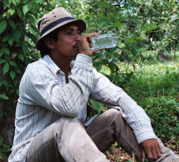Heat and Cold Exposure

Heat-related illness Across the U.S., agricultural workers are at high risk for heat-related illness. For example, during the period between 1992 and 2006, 68 workers employed in crop production and related services died from heat-related illness. The death rate during this period was 20 times higher than the rate for US civilian workers overall. (Jackson and Rosenberg, 2010). Foreign-born or migrating workers may be at particularly high risk if they are not acclimatized to the environment or to the combination of heat and job demands. In agricultural work, the responsibility for preventing heat-related illness lies with the employer and workers. Employers should provide plenty of water, shade and allow rest breaks, while workers need to drink water often, before they feel dehydrated, and must resist the temptation to skip breaks in order to increase productivity. Clinicians can play an important role in preventing heat-related illness by talking to patients about the importance of water, shade and rest, and also discussing the effects of alcohol, medications, and clothing. (Excerpted from Preventing heat-related illness among agricultural workers, by Jackson and Rosenberg). Heat-related illness occurs along a continuum of severity from mild to life-threatening, as follows:
- Heat edema, or swelling of the hands and/or feet, is the mildest form of heat related illness.
- Heat cramps are spasms of the muscles of the arms, legs or abdomen, and are a warning sign of developing heat stress.
- Heat syncope postural dizziness indicative of volume depletion.
- Heat exhaustion volume losses restrict ability to compensate through sweating. Core temperature begins to rise. Symptoms include intense thirst, weakness, anxiety, dizziness, fainting, headache. Rest, shade and aggressive oral or IV rehydration needed immediately. Of particular concern is nausea which threatens oral rehydration.
- Heat stroke is life-threatening medical emergency that occurs when compensatory mechanisms are overwhelmed. Core temperatures rise to levels that interfere with normal metabolic functions and threaten serious multi-organ dysfunction. This is a true medical emergency with a high risk of fatality. the heat build-up becomes more than the body can handle. Heat stroke occurs in two forms, classic and exertional:
- Classic heat stroke occurs as a result of excessive environmental temperatures.
- Exertional heat stroke is caused by the production of excess heat in the body through strenuous activity. Heat stroke experienced by farmworkers is a combination of the two.
See Evaluation and Treatment of Heat-Related Illnesses, by R Wexler.
See Management of Heatstroke and Heat Exhaustion, by JL Glazer.
See Heat-related illnesses, an occupational concern for farmworkers, by P Rao.
COLD: During the cold winter months, workers may be outdoors in adverse conditions for extended periods of time. Problems here include local effects of non-freezing cold (chillblains, “immersion foot”) causing long-term vasomotor instability. Local effects of freezing temperatures include frostbite with permanent tissue, neurovascular structures and even bone damage. Hypothermia is the manifestation of systemic effects of cold and is potentially quite serious. More than 700 people die from hypothermia each year in the United States, and the number of injuries related to cold weather is even higher. Frostbite can cause permanent tissue damage and, in severe cases, gangrene. Agricultural workers often come from warm climates and lack proper clothing and knowledge of cold weather conditions.
Additionally farmworkers often perform tasks which require precise hand motions. Workers may avoid wearing proper gloves which can reduce the speed of job performance. They may feel reluctant to report the initial warning signs of frostbite or hypothermia. Job functions performed indoors are often in unheated barns or buildings. Exposure to cold weather conditions during work hours can be aggravated by inadequate housing. For more information, see Cold Injuries, by R. Edlich and colleagues, and the Cold Stress Equation, by US Dept. of Labor.
Farmworker prevention and education links:
Heat
- OSHA’s Campaign to Prevent Heat Illness in Outdoor Workers
- OSHA’s Heat Index
- Heat Stress: Farmworker Health & Safety by AFOP (Assoc. Farmworker Opportunity Programs)
- Heat Stress-English (PDF 36K) by OSHA
- Heat Stress-Spanish (PDF 24K) by OSHA
- NYCAMH Beat the Heat! (English) and ¡Gánele al calor! (Spanish)
- NYCAMH The Heat Equation
- NYCAMH Preventing Heat Illnesses
- NYCAMH Protect Yourself from the Sun
Cold
- Cold weather task sheet, by Penn State University
- Cold Stress-English (PDF 21K) by OSHA
- Cold Stress-Spanish (PDF 21K) by OSHA
- NYCAMH Avoiding Cold Weather Injuries (English) and Consejos de seguridad para el frío de invierno (Spanish)
- NYCAMH NYCAMH Staying Safe and Warm in Winter Weather
- NYCAMH NYCAMH Stay Safe in Winter Weather (English) and Precauciones con el frío (Spanish)
Back to Common Farmworker Health Conditions and Diagnostic Tools